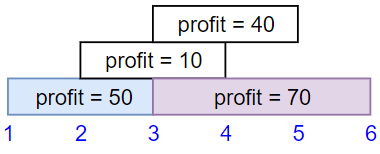動機
top-down: 好寫、但沒有過去的訊息 bottom-up: 不好寫、有過去的訊息 (bsearch!!)、很好做求到此點最大的題目
Problem
We have n jobs, where every job is scheduled to be done from startTime[i] to endTime[i], obtaining a profit of profit[i].
You're given the startTime, endTime and profit arrays, return the maximum profit you can take such that there are no two jobs in the subset with overlapping time range.
If you choose a job that ends at time X you will be able to start another job that starts at time X.
Example 1:

Input: startTime = [1,2,3,3], endTime = [3,4,5,6], profit = [50,10,40,70]Output: 120Explanation: The subset chosen is the first and fourth job. Time range [1-3]+[3-6] , we get profit of 120 = 50 + 70.
Example 2:

Input: startTime = [1,2,3,4,6], endTime = [3,5,10,6,9], profit = [20,20,100,70,60]Output: 150Explanation: The subset chosen is the first, fourth and fifth job. Profit obtained 150 = 20 + 70 + 60.
Example 3:

Input: startTime = [1,1,1], endTime = [2,3,4], profit = [5,6,4]Output: 6
Constraints:
1 <= startTime.length == endTime.length == profit.length <= 5 * 1041 <= startTime[i] < endTime[i] <= 1091 <= profit[i] <= 104
Sol
從哪個點開始延伸? 最靠近起點的點,所以找起點加1的lowerbound
class Solution:
def jobScheduling(self, startTime: List[int], endTime: List[int], profit: List[int]) -> int:
segs = list(zip(startTime, endTime, profit))
segs.sort(key=lambda x: [x[1], x[2], x[0]])
dp = [[0,0]]
for s,e,p in segs:
i = bisect.bisect_left(dp, [s+1])-1
if dp[i][1]+p >= dp[-1][1]:
dp += [e,dp[i][1]+p],
return dp[-1][1]